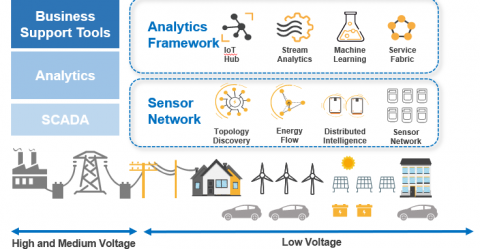
Gaining Visibility of the Low Voltage Grid
Apr 26, 2021With the publicity on business analytics, big data and AI, one is sometimes left wondering if there is anywhere where these innovative uses of technology can’t enrich our lives. We sense that “the answer is business analytics, big data and AI; now what is the question?”.
The question may end up being “how do we use this great technology and the significant financial investments we have made in it when we can’t get the data?”.
A key concept of the smart grid is to use information from the smart devices embedded into the grid to become more efficient in our distribution and use of energy. Again, we hear that business analytics, big data and AI are there and ready to number-crunch that data to generate actionable business insight.
That’s great for those parts of the grid which have the embedded smart drivers and the information ready to hand.
The low voltage grid is the part of the grid between the sub-station transformers (the things in cabinets on the side of the road with lots of cables which sometimes hum gently) and the consumer. It is notoriously difficult to gather information from. The edge points often have some form of intelligent device in the form of smart meters, but even then, what happens within the low voltage grid is often hidden from view. The low voltage grid is, in essence, cables connected together in a star configuration – not much intelligence or sources of information in there.
And yet, it is the low voltage grid which is undergoing a massive transformation, driven by local generation, demand response and electric vehicle introduction. This is also the point of contact between the energy distributor and their customer and the point of delivery of the utility’s service.
So, the question now becomes “how do we get information from this part of the grid to enable our investment in business analytics, big data and AI?”.
The answer turns out to be smart meters communicating via Power Line Communications technology.
These devices can intelligently use the communications statistics (signal strength, signal to noise ratio, crosstalk) to build a topology model for the cables and connections within the low voltage grid.
With a knowledge of topology, these same devices, and intelligent software behind them, can look at the energy flows within the low voltage grid, and provide new insight to the big data systems that are crying out for information from this part of the smart grid.
This information can be used to help the energy distribution company to:
- Identify faults at specific points in the low voltage grid and send the field engineer to the root-cause rather than the symptomatic outcomes at the end customer
- Identify the scope and impact of a fault and drive priority based on sociological impacts
- Identify those parts of the grid which are imbalanced, so wasting energy in the form of heat and vibration (remember the humming that we sometimes hear?) and also suffering excessive wear and tear
- Identify those parts of the grid which are overloaded (wasting energy) or underloaded (wasted investment)
- Assess the readiness of the grid to accept increased local generation or increased demand from electric vehicle charging.
NES Grid Navigation and Grid Flow are great examples of solutions which focus on providing the much-needed visibility of the low voltage grid.
Author:
Jon Wells - Vice President of Customer Solutions at NES
*Watch the video and find out more about Grid Navigator & Grid Flow Applications.




